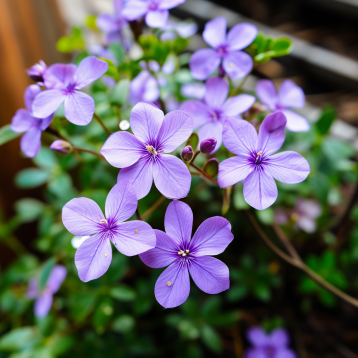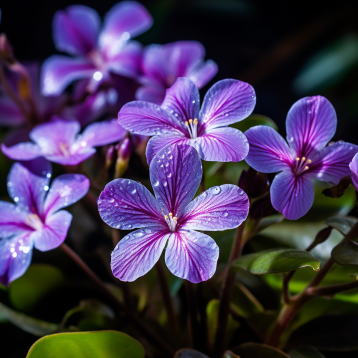Calmandula (CAL-man-DEW-luh)
Calmandula is a periwinkle-flowered sedative herb that induces tranquility and provides natural relief for anxiety, nausea, and sleep issues.
Basic Information
Growth Rate & Stages
The Calmandula emerges rapidly once its seeds germinate in the rich, shaded forest. Within days, tiny heart-shaped leaves unfurl from the delicate seedlings. Quickly climbing and spreading via trailing vines, the young Calmandula weaves through the forest floor to blanket the ground in a carpet of greenery within weeks.
After just six weeks of vigorous growth, the first light purple five-petaled flowers begin to bud among the vines' leaves. Soon the forest floor transitions into a tranquil floral display as the medicinal blossoms bloom in abundance. The calming fragrance intensifies as pollinators ensure cross-pollination during this flowering stage.
Within two months of germination, the Calmandula reaches its peak size, with vines spreading three feet in diameter across the shaded woodland floor. As the flowering period ends, small nutlets form, containing the seeds for future Calmandula generations.
By midsummer, the annual plant begins to wither, its medicinal chemistry concentrated in the dying flowers and leaves. This signals the ideal time for harvest of the calming botanical medicine. Soon after, the nutlets mature and split open, dispersing seeds to propagate more vines.
The relatively short seasonal life cycle allows this visually stunning Calmandula to complete multiple generations over the warmer months before winter dormancy. Come spring, its seeds will again blanket the forest floor with the tranquilizing blossoms.
Ecology and Habitats
Calmandula flourishes in partially shaded forest settings with moist, nutrient-rich soil. Sunlight filtering through the canopy provides the perfect amount of light. Ample rainfall and humidity allow the plants to thrive, but good drainage prevents waterlogging.
Sheltered among the trees, the delicate vines and flowers remain protected from harsh winds that could otherwise damage them. Temperate weather supports the seasonal growth cycle, with warm sunny days for photosynthesis and cool nights.
Populations of busy pollinators like bees and butterflies ensure the flowers get thoroughly fertilized as they flutter about. This allows abundant seed production for future generations.
With lush soil, filtered light, sufficient rain, and help from local pollinators, the Calmandula spreads readily across the forest floor. The plants grow rapidly to form a beautiful carpet of calming blossoms and therapeutic leaves under the shady canopy.
Few herbivores or pests can be found in this haven, allowing the medicinal plants to reach their full potential. The rich forest ecosystem provides ideal conditions to nurture these special herbs.
Grown in harmony with nature, without exposure to extremes, the Calmandula flourishes and shares its gifts of tranquility and healing. The plants impart a peaceful aura that infuses the entire woodland.
Additional Information
Uses, Products & Exploitation
Calmandula is a sedative plant that contains medicinal compounds capable of inducing tranquility and relaxation. The primary use of this flowering plant is as a natural anxiety and sleep aid. Dried leaves and flowers can be made into a soothing evening tea to unwind and de-stress.
In addition to its sedative properties, Calmandula is helpful in alleviating nausea. The root of the plant contains different active compounds that are thought to have stomach-settling effects.
Making a tea from Calmandula roots helps settle an upset stomach and ease feelings of nausea. Sipping the tea slowly allows the antinausea compounds to be absorbed and take effect. The earthy, mildly minty flavor provides a soothing experience.





I think it would be lovely to take a nap in a patch of these, although the bees might be a problem. Well done article!
Thank you! Laying down in a nice patch of flowers sounds good any day.